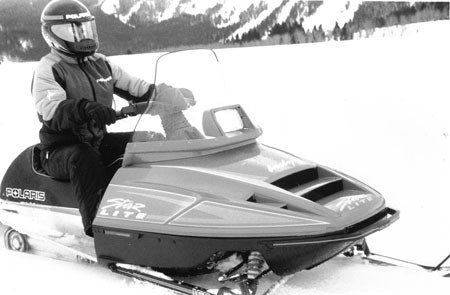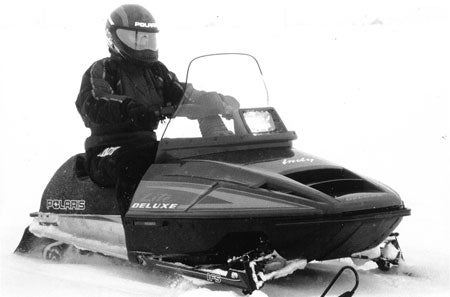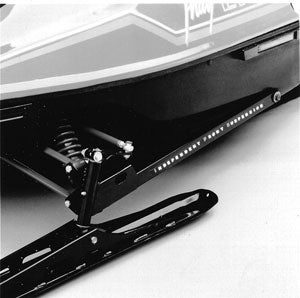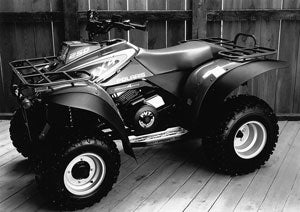1991 Polaris Indy Lite Vintage Review

Polaris' Lite reinvents the entry level sled
Polaris reinvented the idea of “entry level” sleds when it introduced the 1991 Indy Lite. First of all, these models — a basic 244cc single cylinder version and a twin cylinder 340cc version — were essentially full-sized “grown-up” sleds at a time when the “budget” sled niche consisted of smallish, stripped down models. Secondly, being Polaris models, they featured full production, Polaris pioneered independent front suspensions with a wide 36.5-inch ski stance. And they were priced competitively with the other guys’ introductory models.
Said Polaris’ then-snowmobile manager, Bob Nygaard, “What you have is a very affordable, easy handling sled that retails for the same money as a 1990 Ski-Doo Elan, only about $30 more than a leafsprung (Arctic Cat) Jag, and less money than a Ski-Doo Citation or Yamaha Bravo.”
Under development for four years prior to its late 1990 introduction, the Polaris Indy Lite surpassed any similar model Polaris had ever built in its price range. For a 1991 base price of US$2,199, the Indy Lite came standard with a trailing arm front suspension providing 6.25-inches of travel and a rear suspension offering up to 5-inches of travel. Perhaps modest by today’s standards, the travel was generous for the day.
 Selling for US$2,199 the base Indy StarLite offered IFS and direct drive at an affordable price.
Selling for US$2,199 the base Indy StarLite offered IFS and direct drive at an affordable price.The Lite series replaced older, leafsprung models, which used the same Fuji-built, fan-cooled 2-cycle powerplants. The base 244cc single cylinder motor enjoyed a strong reputation for reliability. In fact, it powered the first Polaris ATVs, where it could muster above average performance thanks to the reduced friction of four wheels versus a 15-inch wide by 116-inch long molded rubber track.
When we test rode the Lites back in the day, we commented on the difference between the 244 and the 340 models. At the time, we stated: “The complete character of the Star Lite (244cc) chassis changes when you move up from the single cylinder to the twin cylinder (340cc) Indy Lite.”
While many of the features were shared between the two Lite models, the added power of the twin created a vastly better opinion of the Indy Lite. It went from being a low-buck, basic snowmobile option to a sporty, fun to ride option. Of course, there was a US$600 increase in price for the improved performance.
 Polaris introduced the Indy Lite in 1991 but would expand the line to include this “Deluxe” version as well as a two-up touring model.
Polaris introduced the Indy Lite in 1991 but would expand the line to include this “Deluxe” version as well as a two-up touring model.The two sleds, while similar in design, performed quite differently. Where you had to flog the Star Lite’s single to approach 50 miles per hour, the 340 Indy Lite sped past that number, giving performance similar to the Polaris Indy Sport 440. You could expect the 340 to get beyond 60 mph — even tickle the speedometer to the 70 mph mark if you were on hardpack and heading downhill.
 Based on Polaris’ popular independent front suspension, the Indy Lite showcased a special version for price-savvy buyers.
Based on Polaris’ popular independent front suspension, the Indy Lite showcased a special version for price-savvy buyers.On the trail, the Indy Lite personality differed significantly from the standard “big” Indys. While the IFS concept may have been similar, to save money the Indy Lite models came without a stabilizer bar and used very basic shocks. This worked to give the Lites a decidedly different feel for a Polaris IFS model. There was more pitch and roll than you’d expect from a standard Indy. Of course, we were younger back then and rode the Indy Lites much harder than the intended target market. If ridden as intended, you ended up with a somewhat soft, though fully compliant ride. As for that front end, the suspension might have dipped some, but its 6.25 inches of travel held the corners even when flogged in anger. Thankfully, Indy Lite owners could visit their local Polaris dealership for a variety of shock and spring upgrades to get the ride set to their liking.
In addition to borrowing suspension concepts from existing designs, Polaris brought over concepts from its ATV designs to the sled market. To shave weight, the Indy Lite hood borrowed a polypropylene construction from its ATV models. At the time, most snowmobile hoods were either constructed of fiberglass or Metton, which was a popular reinforced impact material. Yamaha opted for a similar plastic material for the bodywork on its SnoScoot.
As it turns out, Polaris’ hood material suffered from use. A trip through the bush left the early poly hoods marred and dull. Over the years Polaris upgraded the Indy Lite hood and it was no longer a problem by the time the last Indy Lites rolled off the Roseau, Minn. production line.
To hold the engine and primary drive, Polaris Indy Lites combined a steel bulkhead with a lightweight aluminum tunnel. Polyethylene was used for the belly pan.
 Polaris brought some ATV ideas into its Indy Lites, including the base 244cc single, poly plastic material for the hood and the ATV’s drive clutch.
Polaris brought some ATV ideas into its Indy Lites, including the base 244cc single, poly plastic material for the hood and the ATV’s drive clutch.The engines were proven, as was the “Involite” drive train. This was an upgraded version of the direct drive system used on the Polaris Cutlass models and pioneered by John Deere’s Spitfire. The idea was to simplify the drive by connecting the primary clutch to a secondary drive mounted directly on the drive axle. It worked quite well on lower horsepower sleds like the 340 and 244 Lites, drastically reducing the number of drivetrain components. Again the ATV side contributed to the Indy Lites. The four-wheeler’s drive clutch, which was a downsized version of the best sled clutch, crossed platforms and made up the power part of the Lite’s Involite drive system.
The sleds enjoyed handsome styling with Porsche Red highlighting the top line Indy Lite version and a Star Blue coloration for the base model. The black seat was ample in both comfort and overall room. The handlebar area was clean and the bar ends sat tall and were easy to reach. The windshield functioned well, effectively protecting the rider. While these sleds were designed for the cost-conscious snowmobiler, they offered high visual appeal as the overall design came complete with a sporty front air intake and nicely finished details around the console. All in all, the 1991 Indy Lite presented a very favorable option for the snowmobiler looking to enjoy the sport with an inexpensive sled that didn’t look cheap!
We suspect that there are some Indy Lites available for sale that will provide respectable service for winters to come. This was a good design built around proven parts and concepts. Polaris introduced the Indy Lites to help celebrate its 35th anniversary as a snowmobile company. We’d say that the 1991 introduction made its point and spoke well of this Minnesota snowmobile maker.
1991 Polaris Indy Lite & StarLite Specs
| 1991 Indy Lite | 1991 Indy StarLite | |
| Engine | Polaris/Fuji 339cc fan-cooled twin; dual Mikuni VM Slide Carbs; single exhaust | Polaris/Fuji 244cc fan-cooled single; Mikuni VM Slide Carb; single exhaust |
| Horsepower | N/A | N/A |
| Drive | Involite direct drive with Polaris primary & secondary | Involite direct drive with Polaris primary & secondary |
| Front Suspension | Polaris trailing arm IFS, 6.25-inch of travel | Polaris trailing arm IFS, 6.25-inch of travel |
| Rear Suspension | Polaris parallel rail slide; 5 inches travel; shocks with coil spring adjustment | Polaris parallel rail slide; 5 inches travel; shocks with coil spring adjustment |
| Length | 103.0 in | 103.0 in |
| Height | 46.0 in | 46.0 in |
| Width | 27.9 in | 37.9 in |
| Ski Stance | 36.5 in | 36.5 in |
| Track | 15 x 116 molded rubber | 15 x 116 molded rubber |
| Weight | 367 lb | 340 lb |
| Fuel Capacity | 7.2 US Gal | 7.2 US Gal |
| MSRP | $2,799 | $2,199 |
Related Reading
1991 Polaris Indy 650 RXL EFI
1980 Polaris Galaxy Review








 Your Privacy Choices
Your Privacy Choices